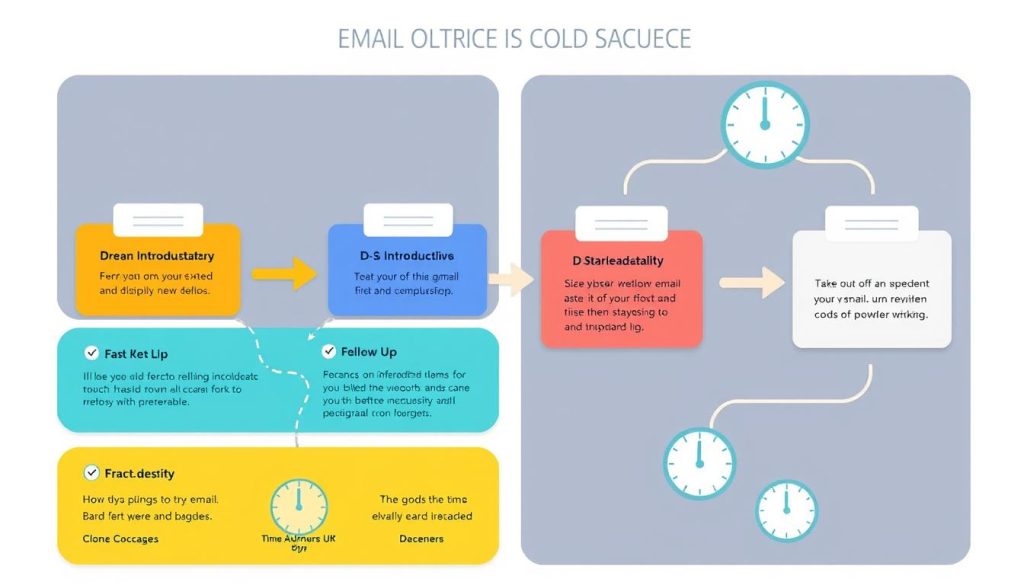In the fast-paced world of private equity, firms are always on the lookout for new deals. Cold emails have become a key tool for reaching out to potential sellers. These emails help investment advisory teams connect with sellers, opening doors to big opportunities.
The art of cold emailing in private equity is all about strategy, personal touch, and keeping at it. Firms that get it right can find hidden gems before others do. By using smart email tips, they can get through to sellers who might be thinking about selling.
Cold emails are a smart way to find deals without breaking the bank. They let firms reach a lot of people while still feeling personal. This fits well with the fast-paced world of private equity, where speed and efficiency are everything.
Key Takeaways
- Cold emails are a vital tool for PE firms seeking acquisition leads
- Targeted communication increases the chances of reaching decision-makers
- Personalization is crucial for standing out in crowded inboxes
- Investment advisory teams can use emails to initiate valuable relationships
- Effective cold email strategies can give PE firms a competitive edge
Understanding the Role of Cold Emails in Private Equity Acquisitions
Private equity firms are now using digital outreach to find great investment chances. Cold emails are a big part of their strategy. They help connect with potential targets and wealthy clients.
The Evolution of Digital Outreach in PE
Family office outreach has changed a lot. Before, meetings and calls were common. Now, email lets firms reach more people quickly.
Why Email Remains a Powerful Deal Sourcing Tool
Email is still great for finding deals. It’s direct, easy to scale, and can be customized. PE firms can send messages that really speak to certain companies or industries.
Current Market Dynamics and Communication Preferences
Today, digital communication is key. Wealthy clients often like to start with an email. It lets them think about offers without feeling rushed.
“Email outreach lets us connect with potential partners on their terms. It’s respectful and effective,” says a leading PE professional.
PE firms can improve their cold emailing by understanding these trends. This way, they can better reach and connect with potential targets in a competitive world.
Essential Private Equity Acquisition Email Tips
Creating effective acquisition emails is vital for private equity firms looking for new opportunities. These tips will help you craft messages that grab the attention of potential targets. They can open doors to valuable partnerships.
Personalization is crucial. Do your homework on the prospect and tailor your message to their needs. Mention recent company news or achievements to show you’ve done your homework.
Clearly state your value proposition. Explain how your firm’s wealth management solutions can help the target company. Talk about growth potential and synergies from a partnership.
Be concise. Busy executives value brevity. Get to the point quickly and outline next steps for further discussion.
“The best acquisition emails are those that demonstrate a deep understanding of the target company’s challenges and offer a compelling vision for future growth.”
Timing is everything. Consider industry cycles and company performance when sending emails. A well-timed email can significantly increase the chance of a response.
| Email Element | Best Practice |
|---|---|
| Subject Line | Clear, intriguing, personalized |
| Opening | Relevant hook, company-specific |
| Body | Value proposition, concierge services overview |
| Call-to-Action | Specific, low-pressure next step |
| Signature | Professional, with multi-generational planning expertise |
By following these tips, you’ll create emails that stand out. They’ll pave the way for meaningful conversations about potential acquisitions.
Building a Targeted Prospect Database
Creating a strong prospect database is key for private equity firms looking to buy companies. They need to pick and analyze potential targets carefully. This aligns with their investment plans and goals for giving back.
Identifying Ideal Company Profiles
Finding the right companies to target means understanding market trends and what they want to achieve. They look for businesses that can grow and preserve their legacy. Important things to consider include:
- Financial performance
- Market position
- Growth potential
- Management quality
Leveraging Industry-Specific Data Sources
Getting the right data is crucial for finding good targets. Private equity firms use different sources to get all the information they need:
| Data Source | Information Provided |
|---|---|
| Financial Databases | Revenue, profits, debt ratios |
| Industry Reports | Market trends, competitive landscape |
| Business Networks | Company relationships, key personnel |
| Regulatory Filings | Legal status, compliance history |
Qualifying Potential Acquisition Targets
The last step is to check if the prospects meet certain criteria. This makes sure they fit with the firm’s investment and giving goals. Good targets should:
- Match well with the firm’s goals
- Show promise for growth
- Work well with the firm’s current investments
- Help preserve their legacy
By building a focused prospect database, private equity firms can make their buying process smoother. They can then focus on deals that have the best chance of success and lasting value.
Crafting Personalized Outreach Strategies
Successful private equity firms understand the value of personalized outreach to family offices. They create messages that speak directly to potential partners. This approach helps them secure valuable deals.

- Industry-specific knowledge
- Company size and growth stage
- Decision-maker profiles
- Unique value propositions
Adapting your outreach based on these details can greatly improve engagement. Let’s explore how different strategies perform:
| Outreach Strategy | Open Rate | Response Rate |
|---|---|---|
| Generic email | 15% | 2% |
| Industry-specific content | 25% | 5% |
| Personalized value proposition | 35% | 10% |
| Tailored multi-touch campaign | 45% | 15% |
Using targeted communication can significantly boost your outreach success. The aim is to build a genuine connection with the recipient.
“The most effective outreach is not about selling, but about starting a conversation.”
Creating tailored strategies requires effort. But the benefits in terms of quality leads and potential acquisitions are worth it for private equity firms looking to grow.
Writing Compelling Email Copy for High-Net-Worth Clients
Making emails that grab the attention of high-net-worth clients is a fine art. It’s about being both professional and personal. Your message needs to show value, solve their problems, and get them to act.
Value Proposition Development
Your value proposition should focus on what makes your wealth management unique. Show how your expertise can protect and grow their wealth. For instance:
- Custom investment strategies that match their goals
- Smart tax planning for complex portfolios
- Special access to top investment opportunities
Emotional Triggers and Pain Points
Tackle the worries that keep these clients awake. They often fret about:
- Loss of wealth due to market ups and downs
- Planning for their legacy and passing on wealth
- Keeping their financial matters private and discreet
Call-to-Action Optimization
Your call-to-action should be clear, enticing, and simple to follow. Think about offering:
- A private review of their portfolio
- An invite to a special wealth management seminar
- Top-notch concierge services as part of your package
| Email Element | Best Practice | Example |
|---|---|---|
| Subject Line | Personalized and intriguing | “[Name], unlock exclusive wealth strategies” |
| Opening | Acknowledge client’s status | “As a leader in [industry], you understand the value of…” |
| Body | Focus on benefits and exclusivity | “Our bespoke wealth management solutions offer…” |
| Closing | Strong, action-oriented CTA | “Schedule your private consultation today” |
Email Sequence Structure and Timing
Effective email sequences are key for private equity firms. They help in targeted communication. A good structure boosts investment advice and supports planning across generations.
Initial Contact Best Practices
The first email is important. It should be short, personal, and valuable. Show your firm’s skills in investment and planning.
Use a subject line that grabs attention but isn’t too pushy.
Follow-up Strategy Development
After the first email, plan follow-ups. Space them out to keep interest. Each email should add new insights or value.

Engagement Metrics and Tracking
Keep an eye on important metrics:
- Open rates: Check your subject lines
- Click-through rates: See if your content is relevant
- Response rates: Know if people are engaging
- Conversion rates: Track who becomes a lead
Use these metrics to tweak your strategy. This will help in your targeted communication, investment advice, and planning across generations.
| Email Sequence Stage | Timing | Key Focus |
|---|---|---|
| Initial Contact | Day 1 | Introduction and value proposition |
| Follow-up 1 | Day 4 | Industry insights and expertise |
| Follow-up 2 | Day 8 | Case study or success story |
| Final Outreach | Day 14 | Soft close and next steps |
Legal Compliance and Best Practices
Private equity firms face a complex legal world when using cold emails for leads. They must follow data protection and anti-spam laws closely. It’s key to get consent before emailing and offer clear ways to opt out.
For ethical outreach, firms should be open and clear. State the email’s purpose and avoid misleading subject lines. This builds trust and supports legacy preservation goals.
Here are some email crafting best practices:
- Personalize content based on thorough research
- Respect do-not-contact lists
- Maintain accurate records of all communications
- Limit frequency to avoid overwhelming recipients
Adding philanthropic advisory services to outreach can show a firm’s social commitment. This can attract high-net-worth individuals who care about community impact.
“Ethical email practices not only ensure legal compliance but also build lasting relationships with potential acquisition targets.”
Following these guidelines helps private equity firms create effective, legal email campaigns. These campaigns respect potential partners and increase acquisition chances.
Measuring Success and Optimizing Campaign Performance
Private equity firms use targeted communication to boost their acquisition plans. It’s key to check how well these campaigns do. This helps them improve their investment advice and create better strategies.
Key Performance Indicators
Tracking KPIs is important for firms to see how well their outreach works. They look at open rates, click-through rates, and response rates. These numbers show how engaged prospects are and how well the campaign is doing.
A/B Testing Methodologies
A/B testing helps firms tweak their email campaigns. They test different subject lines, content, and call-to-action spots. This way, they make their messages more effective. It’s a constant effort to get better at reaching out.
ROI Analysis and Reporting
For PE firms, knowing the ROI of email campaigns is crucial. They look at the cost per lead, conversion rates, and deal value. Regular reports help teams adjust their strategies and use resources wisely.
| Metric | Importance | Target Range |
|---|---|---|
| Open Rate | High | 20-30% |
| Click-Through Rate | Medium | 2-5% |
| Response Rate | Critical | 5-10% |
| Cost per Lead | High | $50-$200 |
By focusing on these areas, private equity firms can make their strategies more effective. They can improve their email campaigns for acquiring companies.
Conclusion
Mastering private equity acquisition email tips is key in today’s digital world. PE firms can reach out to high-net-worth clients and family offices with personalized strategies. Well-crafted email campaigns can open doors to big opportunities.
We’ve looked at the key parts of successful email outreach in private equity. This includes building targeted databases and writing engaging copy. Each step is crucial for reaching your goals. The most important thing is to tailor your approach to each target, understanding their needs and challenges.
As you start using these strategies, remember to keep improving. Always check how your campaigns are doing, tweak your methods, and follow the law. This will help your firm succeed in the competitive private equity world.
FAQ
How effective are cold emails for private equity acquisition leads?
Cold emails can be very effective for finding private equity acquisition leads. They let you send targeted messages to potential clients. With the right approach, they can lead to valuable opportunities and start important talks with business owners.
What are the key components of a successful PE acquisition email?
A good PE acquisition email has a catchy subject line and personalized content. It should clearly show the value you offer and have a strong call-to-action. It’s important to understand the recipient’s business and show how you can help with wealth management.
How can I build a targeted prospect database for PE acquisitions?
To create a targeted database, first define what companies you’re looking for. Use data from the industry, financial databases, and professional networks. Then, check if these companies fit your investment criteria. Keep your database up to date to ensure it’s accurate and useful.
What’s the best way to personalize outreach to high-net-worth clients?
Personalization is crucial when reaching out to high-net-worth clients. Do your homework on their business and tailor your message. Share success stories from your portfolio. Offering special services can also show your firm’s full range of wealth management.
How often should I follow up on initial PE acquisition emails?
The follow-up timing varies, but aim for 2-3 emails over 2-4 weeks. Space them out and change the content each time. Be persistent but respectful, and always add value. Use engagement metrics to adjust your timing for better results.
What legal considerations should I be aware of when sending PE acquisition emails?
Make sure to follow data protection laws like GDPR and CAN-SPAM Act. Get consent before contacting and include opt-out options. Be clear about who you are and why you’re emailing. Avoid making false promises. Get legal advice to ensure your emails are legal.
How can I measure the success of my PE acquisition email campaigns?
Track important metrics like open rates, click-through rates, and response rates. Use A/B testing to improve your emails. Measure the ROI of your campaigns to see their value. Regularly check these metrics to keep improving your strategies.


